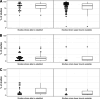Gaps in the usage and reporting of multiple imputation for incomplete data: findings from a scoping review of observational studies addressing causal questions
- PMID: 39232661
- PMCID: PMC11373423
- DOI: 10.1186/s12874-024-02302-6
Gaps in the usage and reporting of multiple imputation for incomplete data: findings from a scoping review of observational studies addressing causal questions
Abstract
Background: Missing data are common in observational studies and often occur in several of the variables required when estimating a causal effect, i.e. the exposure, outcome and/or variables used to control for confounding. Analyses involving multiple incomplete variables are not as straightforward as analyses with a single incomplete variable. For example, in the context of multivariable missingness, the standard missing data assumptions ("missing completely at random", "missing at random" [MAR], "missing not at random") are difficult to interpret and assess. It is not clear how the complexities that arise due to multivariable missingness are being addressed in practice. The aim of this study was to review how missing data are managed and reported in observational studies that use multiple imputation (MI) for causal effect estimation, with a particular focus on missing data summaries, missing data assumptions, primary and sensitivity analyses, and MI implementation.
Methods: We searched five top general epidemiology journals for observational studies that aimed to answer a causal research question and used MI, published between January 2019 and December 2021. Article screening and data extraction were performed systematically.
Results: Of the 130 studies included in this review, 108 (83%) derived an analysis sample by excluding individuals with missing data in specific variables (e.g., outcome) and 114 (88%) had multivariable missingness within the analysis sample. Forty-four (34%) studies provided a statement about missing data assumptions, 35 of which stated the MAR assumption, but only 11/44 (25%) studies provided a justification for these assumptions. The number of imputations, MI method and MI software were generally well-reported (71%, 75% and 88% of studies, respectively), while aspects of the imputation model specification were not clear for more than half of the studies. A secondary analysis that used a different approach to handle the missing data was conducted in 69/130 (53%) studies. Of these 69 studies, 68 (99%) lacked a clear justification for the secondary analysis.
Conclusion: Effort is needed to clarify the rationale for and improve the reporting of MI for estimation of causal effects from observational data. We encourage greater transparency in making and reporting analytical decisions related to missing data.
Keywords: Causal inference; Missing data; Missingness mechanism.
© 2024. The Author(s).
Conflict of interest statement
The authors declare no competing interests.
Figures


Similar articles
-
Handling of missing data with multiple imputation in observational studies that address causal questions: protocol for a scoping review.BMJ Open. 2023 Feb 1;13(2):e065576. doi: 10.1136/bmjopen-2022-065576. BMJ Open. 2023. PMID: 36725096 Free PMC article.
-
Recoverability and estimation of causal effects under typical multivariable missingness mechanisms.Biom J. 2024 Apr;66(3):e2200326. doi: 10.1002/bimj.202200326. Biom J. 2024. PMID: 38637322
-
Assumptions and analysis planning in studies with missing data in multiple variables: moving beyond the MCAR/MAR/MNAR classification.Int J Epidemiol. 2023 Aug 2;52(4):1268-1275. doi: 10.1093/ije/dyad008. Int J Epidemiol. 2023. PMID: 36779333 Free PMC article.
-
A review of the use of controlled multiple imputation in randomised controlled trials with missing outcome data.BMC Med Res Methodol. 2021 Apr 15;21(1):72. doi: 10.1186/s12874-021-01261-6. BMC Med Res Methodol. 2021. PMID: 33858355 Free PMC article. Review.
-
Imputation of missing covariate in randomized controlled trials with a continuous outcome: Scoping review and new results.Pharm Stat. 2020 Nov;19(6):840-860. doi: 10.1002/pst.2041. Epub 2020 Jun 8. Pharm Stat. 2020. PMID: 32510791 Free PMC article.
Cited by
-
The Completeness of the Operating Room Data.Methods Inf Med. 2024 Sep;63(3-04):137-144. doi: 10.1055/a-2566-7958. Epub 2025 Mar 26. Methods Inf Med. 2024. PMID: 40139222 Free PMC article.
-
Research Advance of Causal Inference in Clinical Medicine: A Bibliometrics Analysis via Citespace.J Multidiscip Healthc. 2025 May 10;18:2603-2627. doi: 10.2147/JMDH.S516826. eCollection 2025. J Multidiscip Healthc. 2025. PMID: 40370682 Free PMC article. Review.
References
-
- Lederer DJ, Bell SC, Branson RD, Chalmers JD, Marshall R, Maslove DM, et al. Control of confounding and reporting of results in causal inference studies. Guidance for authors from editors of respiratory, sleep, and critical care journals. Ann Am Thorac Soc. 2019;16(1):22–8. 10.1513/AnnalsATS.201808-564PS - DOI - PubMed
-
- Rubin DB. Multiple imputation for nonresponse in surveys. Hoboken: Wiley; 2004.
-
- Van Buuren S. Flexible imputation of missing data. Boca Raton: CRC Press; 2018.
Publication types
MeSH terms
Grants and funding
LinkOut - more resources
Full Text Sources

